Blogs
List of Development Banks in Nepal | Class B Banks
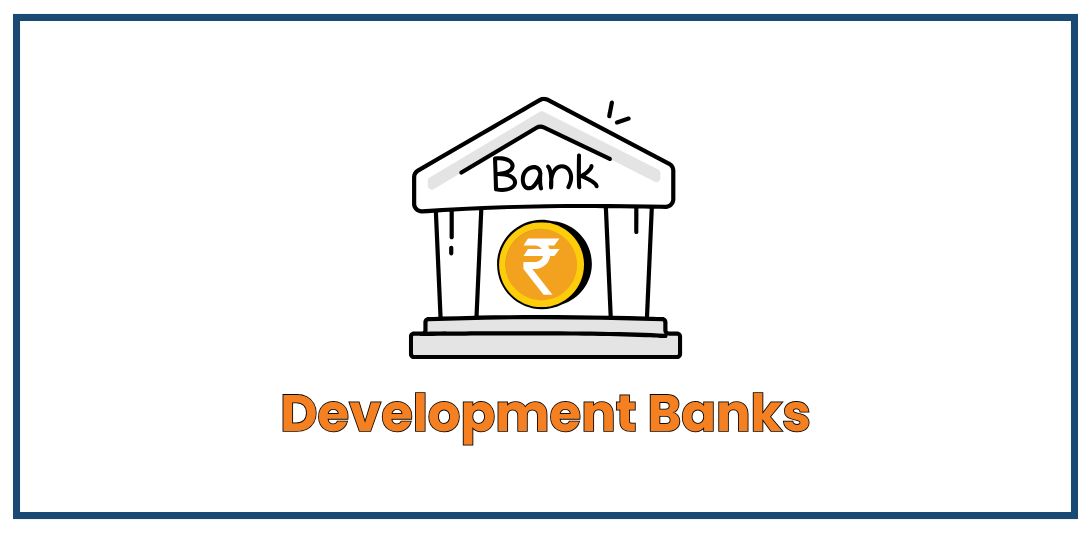
Development Banks are financial institutions that specialize in providing long-term financing for industrial and infrastructure projects. Development banks focus more on agriculture, SMEs (Small and Medium Enterprises), and rural development. Development Banks are also know as the Class B financial institutions. Major services provided by development banks include:
- Loans for Industrial and Economic Projects: Development banks offer loans to businesses, especially in sectors such as agriculture, manufacturing, and services. They aim to boost economic growth and employment.
- Project Financing: These banks provide financing for large-scale infrastructure projects like roads, energy generation, and construction projects.
Development banks are important for improving the country’s infrastructure and industries, helping to boost economic growth and provide support. Nepal Rastra Bank also regulates these banks, but their capital requirements are different from those of commercial banks. There are four types of banks categorized by Nepal Rastra Bank as follows:
-
Class B – Development Banks
List of Development Banks in Nepal
As of March 2025, there are 17 development banks licensed by Nepal Rastra Bank. The development banks are categorized based on their working areas into national, provincial, and district levels. Currently, there are 8 national-level, 6 provincial-level, and 3 district-level development banks in operation. The table below lists all these development banks along with their headquarters, paid-up capital, and website links.
Capital requirements of the development bank in Nepal
Development banks are required to maintain certain capital levels to ensure financial stability and protect depositors. The Nepal Rastra Bank (NRB), the central bank, sets these capital requirements.
Minimum Paid-Up Capital Requirements of Development Banks
The NRB mandates different minimum paid-up capital amounts for development banks based on their operational scope:
- National-Level Development Banks: NPR 2.5 billion
- Development Banks Operating in 4 to 10 Districts: NPR 1.2 billion
- Development Banks Operating in up to 3 Districts: NPR 500 million
These requirements are designed to ensure that development banks have sufficient financial resources to support their operations and absorb potential losses.
Capital Adequacy Ratios
In addition to the paid-up capital, development banks must adhere to capital adequacy ratios as per the Capital Adequacy Framework:
- Core Capital (Tier 1) Ratio: Minimum of 8.5% of risk-weighted assets
- Total Capital Adequacy Ratio (CAR): Minimum of 11% of risk-weighted assets, including both Tier 1 and Tier 2 capital
These ratios help ensure that banks can withstand financial stress and continue to operate effectively. By meeting these capital requirements, development banks in Nepal contribute to the overall health and stability of the country’s financial system.
Blogs
Chhyangdi Hydropower Extends Deadline for Rights Share Application | Until 27th Ashad
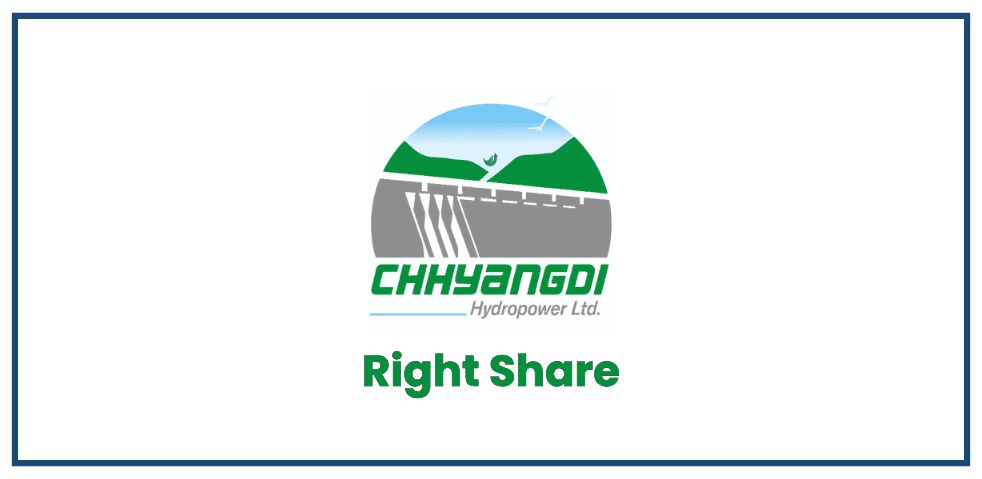
The deadline for the ongoing rights share issue of Chhyangdi Hydropower Limited (CHL) has been officially extended until 27th Ashad, 2082. The issue had originally opened on 23rd Jestha, 2082, with an earlier closing date set for 12th Ashad, 2082.
Key Details of the Rights Share Issue
| Details | Information |
|---|---|
| Total Right Shares Issued | 3,869,775 units (1:1 ratio) |
| Face Value per Share | Rs. 100 |
| Total Issue Amount | Rs. 38.69 Crore |
| Current Paid-up Capital | Rs. 38.69 Crore |
| Post-Issue Paid-up Capital | Rs. 77.39 Crore |
As per the Central Depository System and Clearing Limited (CDSC), 23,503 applicants have applied for 2,317,902 units (worth Rs. 23.17 Crore) as of yesterday.
Eligibility and Application Process
Only those shareholders who held shares before the book closure date of 2nd Jestha, 2082, are eligible for this right share offering.
Interested shareholders can apply through:
- Global IME Capital Limited, Naxal, Kathmandu (Issue Manager)
- Designated branches of Global IME Bank Limited across Lamjung, including Besisahar, Sundarbazar, Bhulbhule, Siundibar, Udipur, and Dordhi
- Any C-ASBA-approved banks and financial institutions
- Online via “MeroShare”.
Applicants are advised to complete the process before banking hours on 27th Ashad, 2082 (Friday).
Important Note:
Payments must be made through an account payee cheque drawn in the name “GICL-BOK-CHHYANGDI RIGHT SHARE”, as per the instructions from Global IME Capital Ltd.
Contact Information
- Chhyangdi Hydropower Ltd
Phone: 977-01-4526483 / 4524925
Email: [email protected] | Website: www.chpl.com.np - Global IME Capital Ltd (Issue Manager)
Phone: 977-01-5970138
Email: [email protected] | Website: www.globalimecapital.com
Notice: Chhyangdi Hydropower Extends Deadline for Rights Share Application
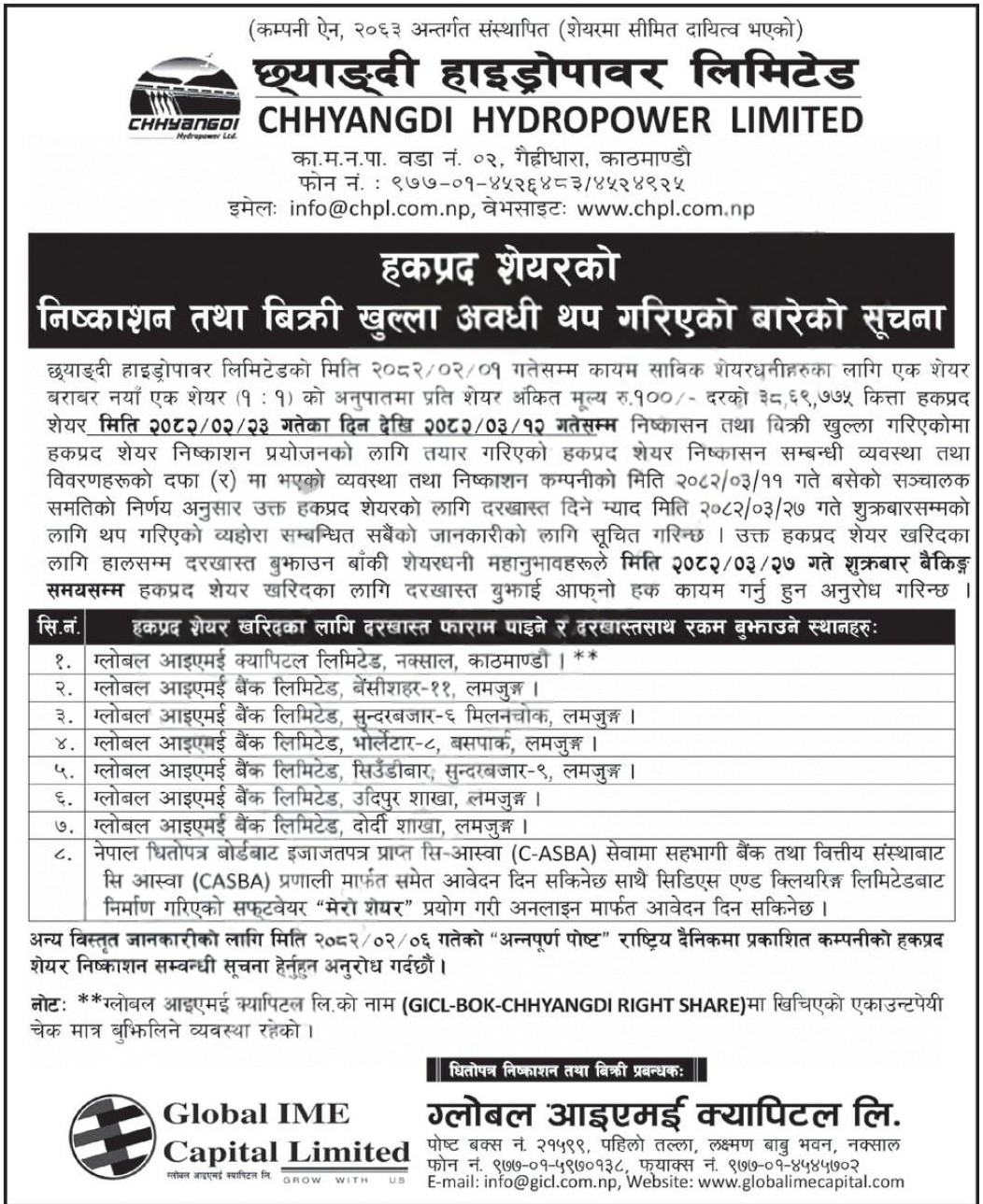
Blogs
Election Commission Preparing to Announce By-Election Date | Voter Registration Now Open
The Election Commission of Nepal has begun preparations for by-elections to fill vacant positions at various levels of government. As part of this process, the Commission is urging all eligible Nepali citizens who have not yet registered their names in the voter list to do so immediately.
According to the Assistant Spokesperson of the Election Commission, Mr. Durga Prasad Chalise, individuals will not be allowed to register in the voter list once the election date is officially announced. Therefore, he emphasized the importance of early registration to avoid being left out.
The Election Commission recently held discussions with the Prime Minister, Mr. KP Sharma Oli, and the Acting Chief Election Commissioner, Mr. Ram Prasad Bhandari. They talked about setting a date for the by-elections. The main focus was on two key areas: Rupandehi Constituency No. 3 for the House of Representatives and Manang Province Assembly Constituency No. 1 (B). Elections in these regions are likely to be held in the second week of Kartik.
The position in Rupandehi became vacant after the passing of Rastriya Prajatantra Party MP Deepak Bohora. In Manang, the seat became empty after provincial assembly member Deepak Manange was sent to jail. In addition to these, more than a dozen ward chairman positions are also currently unoccupied in various local governments.
The Election Commission has issued a public notice dated 2082/03/11 (Nepali calendar) urging all citizens to register in the voter list immediately. The notice mentions that, according to Clause 4(2)(2) of the Voter List Act, 2073, voter registration will be stopped as soon as the election date is declared.
Hence, this is a final chance for anyone who missed earlier opportunities to register. The Commission has made a heartfelt appeal to all brothers and sisters across the country to take this opportunity seriously and get their names included in the voter list.
The Election Commission assures that the upcoming elections will be conducted fairly and freely, in line with its guiding principle:
“Free and Fair Election: Pride of the Nation.”
For more information or assistance, people can visit the official website of the Election Commission at www.election.gov.np or contact their office at Kantipath, Kathmandu.
Notice: Election Commission Preparing to Announce By-Election Date

Blogs
Birgunj Customs Office Collects Highest Revenue from Petroleum Imports
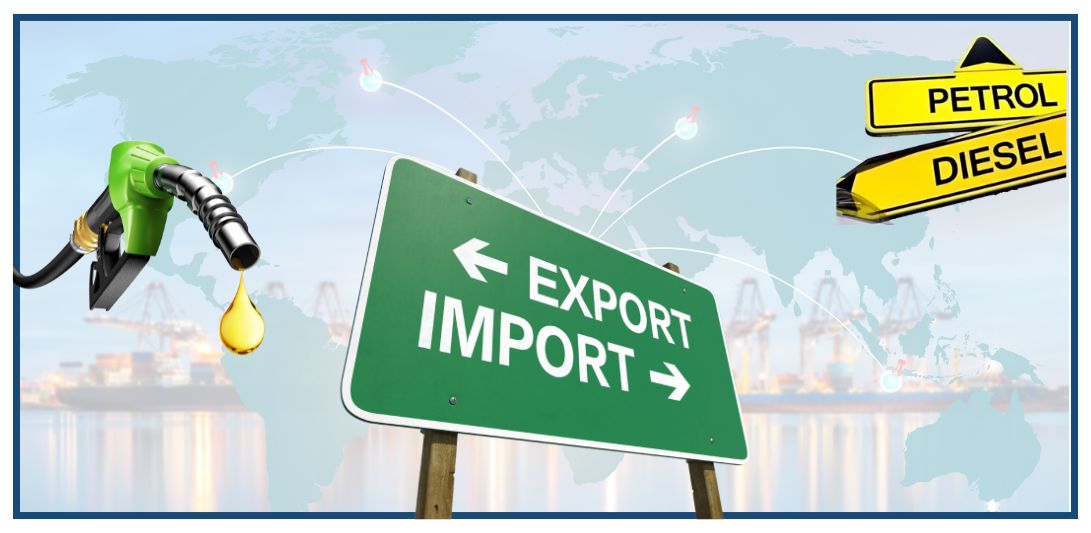
The Birgunj Customs Office has collected the highest revenue from the import of petroleum products in the first 11 months of the current fiscal year 2081/82. According to the office, a total of NPR 73.18 billion was collected in revenue from petroleum imports alone.
During this period, Nepal spent about NPR 174.09 billion to import five different types of petroleum products. These petroleum imports contributed 46.43% of the total revenue collected from the top 20 imported items, making it the most important source of income for the customs office.
Major Revenue Contributors from Imports

What Officials Say
Customs Chief Administrator Deepak Lamichhane stated that petroleum products and vehicle imports are the main sources of customs revenue at Birgunj. He highlighted that these two sectors consistently contribute the highest share of government income collected through imports.
Conclusion
The data from the Birgunj Customs Office shows that fuel and vehicles remain Nepal’s most heavily imported and taxed items. With more than 46% of the revenue coming from petroleum alone, any changes in fuel prices or import volumes can significantly affect national customs revenue.
-
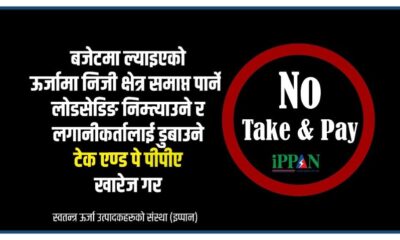
 Blogs4 days ago
Blogs4 days agoPrivate Power Producers Protest ‘Take and Pay’ Provision in Budget
-
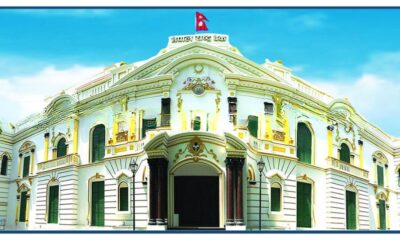
 Blogs4 days ago
Blogs4 days agoNepal Rastra Bank to Withdraw NPR 60 Billion from the Banking System on Monday
-

 Blogs1 year ago
Blogs1 year agoList of Stock Brokers in Nepal with NEPSE TMS Login – Updated
-
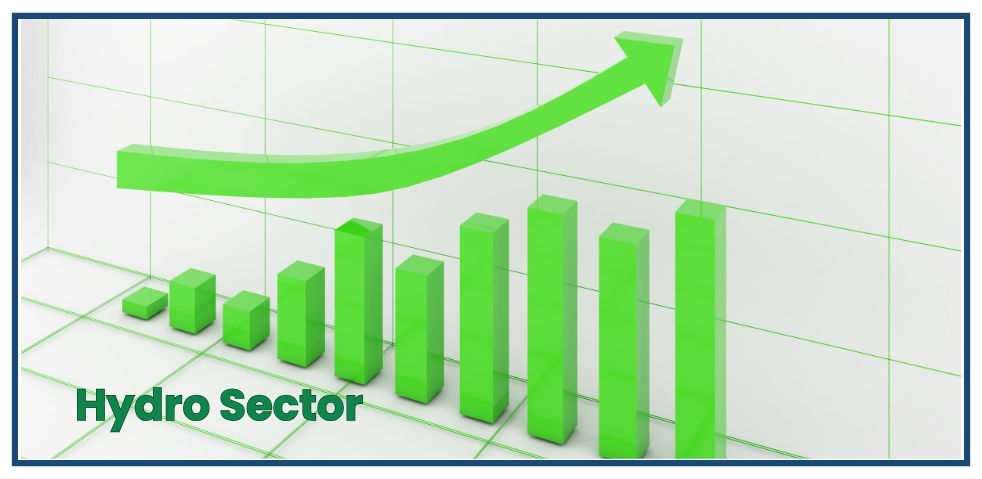
 Blogs1 week ago
Blogs1 week agoHydropower Gains 7.8% in One Month, Outperforming All Sectors
-
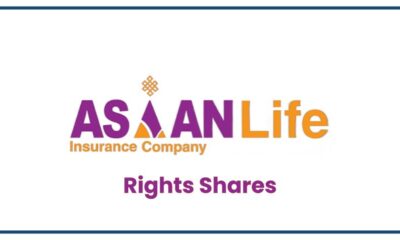
 Blogs5 days ago
Blogs5 days agoAsian Life Insurance to Issue Rights Shares from Asar 25
-

 Blogs3 months ago
Blogs3 months agoPure Energy IPO For General Public
-

 Blogs4 days ago
Blogs4 days ago52-Week Low & High Microfinance Shares in Nepal: Current Status and Future Outlook
-
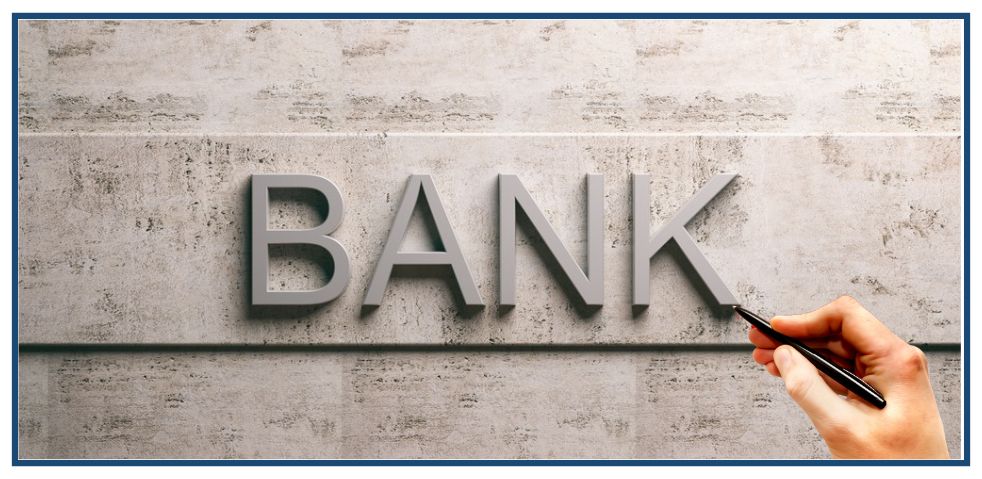
 Blogs1 week ago
Blogs1 week agoBanks Invest Rs. 16.45 Trillion in Directed Loans, 14% in Agriculture Sector | Says Nepal Rastra Bank




